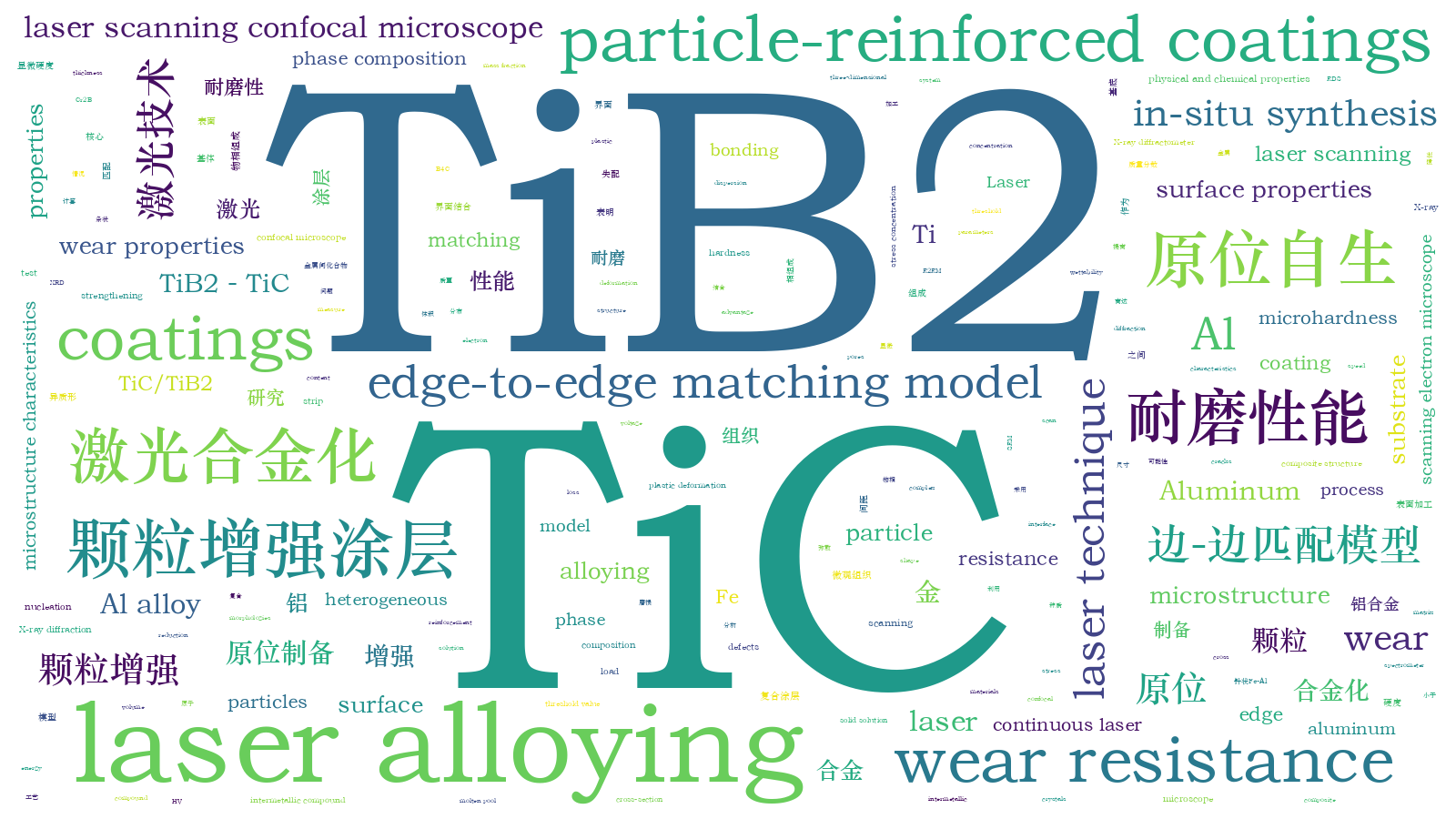激光原位制备TiB2‑TiC颗粒增强铝基涂层的组织及性能研究
The low hardness and poor wear resistance of aluminum materials greatly limit their use in wear environments. Preparing coatings of particle-reinforced aluminum matrix composites (AMCs) by the laser alloying process can effectively improve their surface properties while maintaining their bulk advantage. However, large differences in physical and chemical properties and the low wettability between the particle reinforcements and aluminum melt cause significant stress concentration and plastic deformation at the interface, resulting in serious defects. To further improve the properties, in-situ synthesized TiB2-TiC particle-reinforced AMCs coatings are fabricated by laser alloying on the surface of a 6061 Al alloy using the Ti-B4C system. The phase composition, microstructure, and wear properties of the alloyed coatings with various Ti-B4C mass fractions are investigated. Interfacial matching of in-situ particles is calculated by an edge-to-edge matching model, and the possibility of heterogeneous nucleation is discussed.
Fe-based alloy, Ti, and B4C mixed powders are pre-placed on a 6061 Al alloy substrate with a thickness of 0.4 mm. Then, the laser alloying process is conducted using a continuous laser (Fig.1) to fabricate in-situ TiB2-TiC-reinforced AMCs coatings. The microstructure of the coatings is investigated using a scanning electron microscope (SEM), and the chemical compositions are analyzed with an attached energy dispersive spectrometer (EDS). For the phase constituents of the coatings, X-ray diffraction (XRD) patterns are recorded on an X-ray diffractometer with a working voltage at 40 kV and a scan rate at 10(°)/min. A Vickers microhardness tester is used to measure the hardness distributions of the coatings at a load of 200 g for 10 s. To test the wear resistance of the alloyed coatings, a ball-on-disc wear tester is used. The load is 750 g, and the rotational speed is 350 r/min. After a 20-min test, a laser scanning confocal microscope (CLSM) is used to examine the three-dimensional morphologies and cross-section profiles of the worn surface. Additionally, interfacial matching of the in-situ particles is calculated by an edge-to-edge matching (E2EM) model, and the interfacial microstructure characteristics are analyzed.
Laser alloyed coatings with good metallurgical bonding are obtained under optimized parameters, and the microstructure of the coatings is dense without obvious defects such as cracks and pores (Fig.4). The alloyed coatings are mainly composed of Fe-Al intermetallics and dispersed TiB2 and TiC particle reinforcements. Thermodynamic calculations are given to analyze the complex in-situ chemical reactions in the molten pool (Fig.3). With an increase in the B4C-Ti content, the strip-shaped Fe-Al intermetallic compound in the alloyed coating is obviously refined and gradually transforms into a needle shape, and the mass fraction of in-situ synthesized TiB2 and TiC in the coating increases (Fig.5). Furthermore, the interplanar and interatomic spacing misfit between the Al/TiC and Al/TiB2 are less than the threshold value of the E2EM model, demonstrating strong bonding between the reinforcement and the substrate. Additionally, a low misfit of TiC/TiB2 indicates that TiC crystals can precipitate and grow on the surface of TiB2 by way of heterogeneous nucleation. Finally, the TiB2-TiC composite structure is in-situ formed in the alloyed coating (Figs.7 and 8). The dispersion strengthening of the fine in-situ reinforcing phases and the solid solution strengthening of Fe-Al compounds give rise to high microhardness and good wear resistance.
In-situ synthesized TiB2-TiC particle-reinforced AMCs coatings are fabricated by laser alloying to improve the surface properties of a 6061 Al alloy substrate. The phase composition, microstructure, and wear of the alloyed coatings with various Ti-B4C mass fractions are investigated. The alloyed coatings mainly consist of strip-shaped or needle-shaped Fe-Al intermetallics and small dispersed in-situ reinforcements such as TiB2, TiC, and Cr2B. The misfits between the α-Al/TiC and α-Al/TiB2 phases are less than 10%, demonstrating strong bonding between the reinforcements and the substrate. Additionally, a low misfit of TiC/TiB2 indicates that TiB2 serves as an effective heterogeneous nucleus for TiC during the laser alloying process. The average microhardness of the alloyed coating is 1156.11 HV, approximately 15.2 times that of the substrate. Moreover, an 89.6% reduction in the volume loss significantly enhances wear resistance.
迟一鸣, 钱大虎, 姚喆赫, 张群莉, 刘云峰, 姚建华. 激光原位制备TiB2‑TiC颗粒增强铝基涂层的组织及性能研究[J]. 中国激光, 2023, 50(24): 2402202. Yiming Chi, Dahu Qian, Zhehe Yao, Qunli Zhang, Yunfeng Liu, Jianhua Yao. Microstructure and Properties of Laser In‑situ Synthesized TiB2‑TiC Reinforced Aluminum Matrix Coatings[J]. Chinese Journal of Lasers, 2023, 50(24): 2402202.







